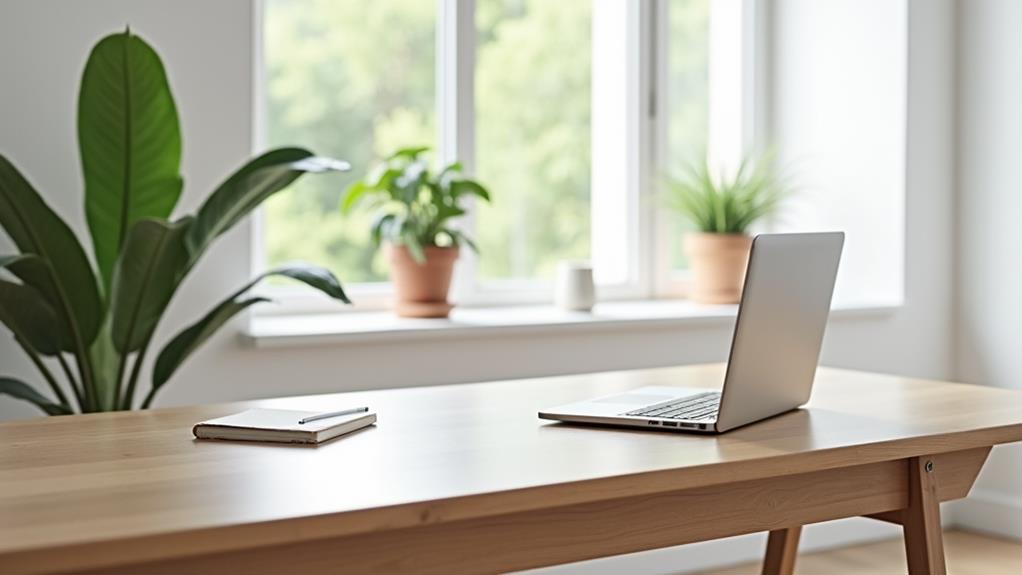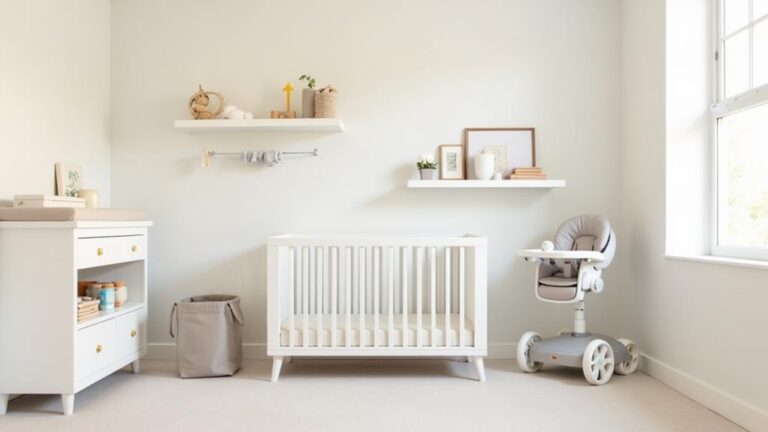Ready to declutter your homeschooling life? Minimalist homeschooling is your ticket to freedom! Focus on the essentials: math, reading, and language arts. Ditch the excess curriculum clutter and embrace quality resources like McGuffey Readers and Math U See. Create a streamlined learning space with clear bins and labeled baskets – your kids will thank you! Establish a consistent daily rhythm, balancing structure with flexibility. And don't forget to leverage technology wisely. Remember, less is more when it comes to nurturing independent learners. By simplifying your approach, you'll rediscover the joy of teaching and watching your children thrive. Want to transform your homeschool journey? There's so much more to explore!
Quick Takeaways
- Focus on core subjects like math and language arts, eliminating unnecessary materials to streamline education.
- Declutter your learning space regularly, involving children to teach responsibility and maintain organization.
- Establish a consistent daily routine with set times for learning, balancing structure and flexibility.
- Prioritize quality resources over quantity, utilizing libraries and hands-on tools for diverse learning opportunities.
- Encourage independent learning by supporting child-led exploration and adapting curriculum to individual learning styles.
Defining Minimalist Homeschooling
Simplicity lies at the heart of minimalist homeschooling. You're probably wondering, "What exactly does that mean?" Well, imagine decluttering your curriculum like you would your closet. It's all about focusing on the essentials—core subjects like math, reading, and language arts—while ditching the unnecessary fluff.
Essential Curriculum Components
Let's explore the essential curriculum components for minimalist homeschooling. As a minimalist homeschooler, you'll want to focus on core subjects without overwhelming your little ones. Language arts, math, and reading form the backbone of your daily rhythm. Incorporate copywork for handwriting and grammar, and don't forget the power of reading aloud! It's not just educational; it's a chance to snuggle up with your kiddos and spark their love for good books.
Here's a quick guide to get you started:
| Subject | Resources | Benefits |
|---|---|---|
| Language Arts | Copywork, McGuffey Readers | Improves writing skills |
| Math | Math U See, manipulatives | Hands-on learning |
| Reading | Library books, read-alouds | Fosters comprehension |
| Science | Nature walks, experiments | Encourages curiosity |
| History | Living books, timelines | Brings the past alive |
Decluttering Your Learning Space

Tidying up your homeschool space can transform your learning environment and boost productivity. Ready to embrace minimalism in your homeschooling journey? Start by ruthlessly evaluating your current learning space. Toss out anything that's not actively used for education. Trust me, it's liberating!
Now, let's organize those essential supplies. Clear bins or labeled baskets are your new best friends. They'll keep books and materials tidy while making them easily accessible for your little learners. Consider using stackable plastic boxes for enhanced visibility and efficient use of vertical space. Fabric storage cubes can also provide versatile options for organizing various homeschool items. And hey, why not involve the kiddos in the decluttering process? It's a great way to teach responsibility.
Don't forget to implement a regular decluttering schedule. Once a month, reassess what you really need. And here's a pro tip: invest in multi-functional furniture. A storage ottoman? Pure genius for maximizing space while keeping things neat and tidy
Simplifying Daily Routines
Establishing a streamlined daily routine is essential for minimalist homeschooling success. You'll want to simplify your homeschool day by creating a consistent rhythm. Set specific times for morning routines, learning sessions, and free play. It's amazing how less stuff and fewer decisions can make your day flow so much smoother!
Keep it simple by limiting subjects each day. Focus on core areas like language arts and math, then rotate in science and art. Oh, and have you tried a morning basket? It's a game-changer! Fill it with shared resources to kickstart your day.
Quality Resources Over Quantity

When it comes to homeschooling resources, quality trumps quantity every time. You don't need a mountain of textbooks to give your kids an amazing education! Instead, focus on a few stellar quality resources like the McGuffey Readers and Logic of English phonics program. These gems provide foundational skills with minimal materials. Maximize vertical space by using hanging organizers with shelves to store your essential homeschooling materials, keeping them easily accessible yet out of the way.
Your local library is a treasure trove! It's like having a free ticket to explore endless subjects. And hey, who doesn't love saving money? Use good literature for copywork and independent reading. It's a win-win for language arts skills and your wallet!
Don't forget hands-on learning. Math U See manipulatives and nature studies through engaging books? Yes, please! The secret sauce? Consistent daily sessions. It's amazing how short, focused lessons lead to significant progress over time. Simplify and watch your kids thrive
Balancing Structure and Flexibility
Striking the right balance between structure and flexibility is key to successful homeschooling. You'll want to establish a daily rhythm that allows for spontaneous learning while maintaining a sense of order. It's like choreographing a dance – you've got the steps, but there's room for improvisation!
| Structure | Flexibility |
|---|---|
| Consistent daily routine | Spontaneous opportunities |
| Core subjects prioritized | Rotating secondary topics |
| Short-term goals set | Adaptable to unique needs |
| Informal assessments | Child-led interests |
Start with a flexible morning routine that covers multiple subjects without overwhelming your little learners. Set educational goals aligned with your family's values, but don't be afraid to adjust based on your child's needs. Remember, you're not just a teacher – you're a guide on this incredible journey! Use informal assessments like narration and hands-on projects to gauge progress. It's all about finding that sweet spot between structure and flexibility.
Technology in Minimalist Homeschooling

Technology in minimalist homeschooling is like a double-edged sword. It can be a game-changer for decluttering your learning space and accessing a world of knowledge. But let's be real, moms – managing screen time can feel like herding cats!
You'll love how digital learning resources like Khan Academy and online classes can replace bulky textbooks. And don't get me started on the magic of library resources for ebooks! It's like having a personal tutor without the clutter.
Want to personalize your kid's learning journey? Educational apps are your new best friend. They'll tailor content faster than you can say "curriculum overload."
But remember, balance is key. Set boundaries around technology use. After all, you don't want your little ones glued to screens 24/7, right? Use it wisely, and watch your minimalist homeschool thrive!
Nurturing Independent Learners
Nurturing independent learners is the cornerstone of minimalist homeschooling. You'll find that children need opportunities to explore their interests and lead their own projects. By encouraging self-directed learning, you're empowering your kids to take charge of their education. Isn't that amazing?
A flexible curriculum adapts to each child's unique style, fostering a love for lifelong learning. But don't forget structure! A consistent routine helps create a balanced environment where independent learners thrive.
| Strategy | Benefit | Example |
|---|---|---|
| Child-led exploration | Deeper engagement | Nature walks |
| Hands-on experiences | Practical skills | Cooking lessons |
| Self-directed projects | Ownership of learning | Building a birdhouse |
| Personalized curriculum | Adapts to learning style | Custom math workbooks |
In your minimalist homeschool, you're not just teaching—you're nurturing curiosity and independence. And that, my friend, is priceless.
Common Questions
How to Be a Minimalist Homeschooler?
To be a minimalist homeschooler, focus on essential subjects, use multi-level resources, and create a simple learning space. Embrace the KISS method, implement a morning routine, and prioritize hands-on experiences. You'll streamline your approach while maintaining educational quality.
How Do You Simplify Homeschooling?
You'll move mountains by simplifying homeschooling! Focus on essentials, create a flexible routine, use library resources, incorporate hands-on learning, and declutter your space. You'll streamline education, reduce stress, and foster a love for learning in your children.
How to Keep Homeschool Simple?
To keep homeschool simple, focus on core subjects, use library resources, and implement a streamlined morning routine. Limit daily sessions to 1-2 hours, declutter your learning space, and integrate secondary subjects flexibly. This approach maximizes efficiency and reduces stress.
How Do You Explain to Your Parents You Want to Be Homeschooled?
Break the ice by presenting your case with facts and figures. You'll want to outline your reasons, propose a plan, and share success stories. Be open to their concerns and show you've thought this through carefully.




